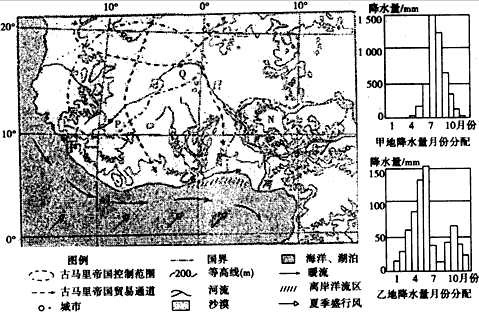阅读分析材料和图表,结合有关知识,完成下列各题。
材料一:
古马里是13世纪一16世纪期间西非草原上繁荣的贸易帝国。图1示意该区域的地理环境。
材料二:
N国是非洲人口大国,需要大量进口粮食。近年来,中国与N国积极合作,在该国推广高产水稻种植。表1表示N国主要粮食作物的构成。

图1

(1)指出尼日尔河从P点到Q点河段的水量变化趋势,并分析其自然原因。
_________________________________________________________________________________________
_________________________________________________________________________________________
(2)比较甲、乙两地6~8月降水量的主要差异,并分析原因。
_________________________________________________________________________________________
_________________________________________________________________________________________
(3)简述在N国推广高产水稻种植将面临的限制性因素。
_________________________________________________________________________________________
_________________________________________________________________________________________
(4)根据古马里帝国所处的地理环境,分析其兴盛的可能原因。
_________________________________________________________________________________________
(1)变化趋势:水量减少。原因:该河段所处区域降水量少,蒸发量大(流经半干旱、干旱地区);少
支流汇入;河水下渗严重。
(2)主要差异:甲地降水明显多于乙地。原因:甲地受来自海洋的西南气流和沿岸暖流影响,地处山地
迎风地带,降水丰富;乙地地形平坦,西南气流受地形抬升不显著,并受离岸寒流影响,降水较少。
(3)水稻种植经验不足,生产技术落后;水利设施不完善,机械化程度低;传统生产观念和主食消费习
惯的影响。
(4)地形平坦;草原广阔;河流水资源较丰富;灌溉农业及牧业较发达;处于古代贸易的交通要道。
